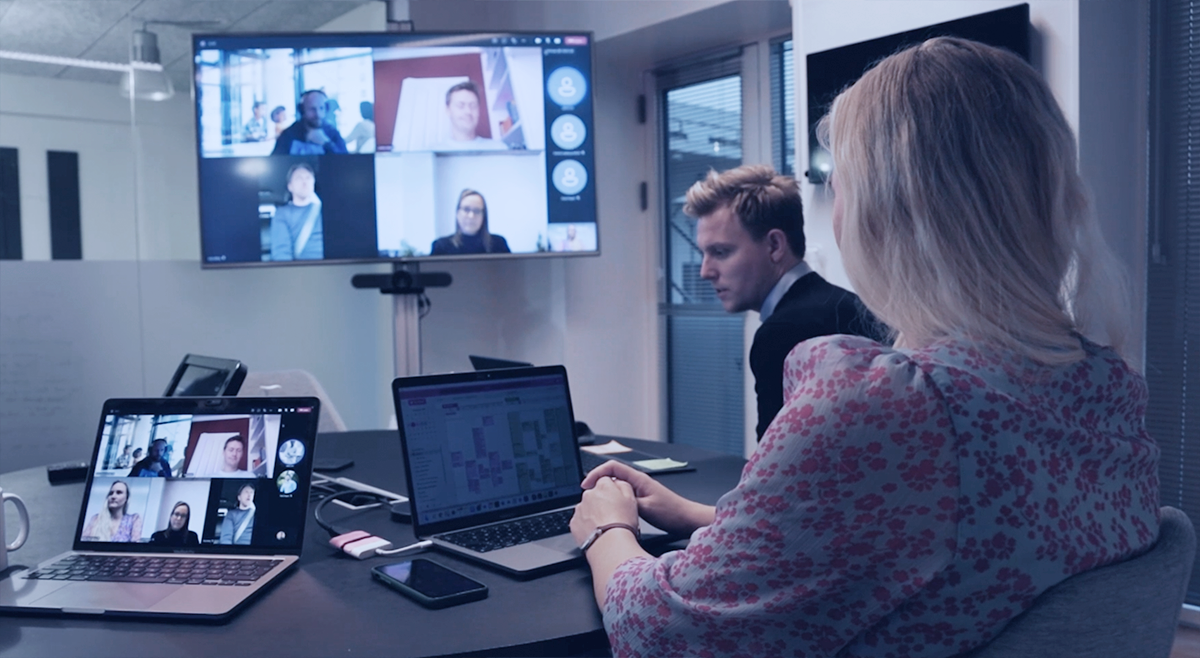
As much as there is to gain from hybrid work there is also something to lose.
It all comes down to the choices and priorities made. How much are you willing to give up on one thing to achieve another?
The world of hybrid work is complex and comes with built-in dilemmas organizations have to understand, accept, and deal with, to make it work. To aid the transition from a traditional to a hybrid workplace, tools such as space management software are available. But before jumping right in and implementing solutions, organizations must understand the challenge, and what they are solving for.
This article provides tangible examples of what you need to consider when transitioning to a hybrid work model, helping you make informed decisions while navigating the new world of hybrid.
Think about what you actually want to achieve: What you want your office to be, feel, and look like, and how you want work to work.
Some dilemmas arise when making hybrid work-related business decisions.
Where is the golden mean, if any?
A hybrid work model requires thought, adjustments, new processes, and structural changes that impact how people work.
Therefore, before jumping to a solution, start by understanding the problem, and what you are solving for.
Every company is different, with different challenges, different people, and different priorities. Two companies in the same sector, competing for the same types of clients, can work and operate in completely different ways - meaning the hybrid challenge, has to be dealt with differently. It’s truly not a “one size fits all” approach.
Hybrid working is here to stay, so doing nothing isn’t an option anymore.
When you know what your challenge is, you must make a plan, outline priorities, and understand the consequences of your choice - for the workplace, employees, culture, and collaboration.
To help you get started, or evaluate if what you’ve already done was right for your organization, we have outlined below some of the most urgent challenges.
Let’s start with a simple one. Should you even consider hybrid work?
Working from home gives flexibility and freedom to the employees, but at the same time, many also crave the community an office space provides. Thus, the need for something in-between is now evident.
A survey of 9,000 workers by Accenture PLC found that 83% of respondents viewed a hybrid workplace as optimal, which means companies need to figure out new ways of working and do so fast.
Your flexibility with hybrid work will affect your ability to attract and also retain talent.
Should we have a physical office at all when people work from home? Or should we simply save the money and go remote?
If organizations go fully remote, how do employees feel part of a business culture, their team, and that they belong at the workplace? What are the cultural consequences of not having a place to be and meet with colleagues? That’s an interesting dilemma to dive into.
Culture aside (for now), when it comes to productivity and growth, many organizations made hybrid work work, and with great results.
Many organizations that are going for the hybrid mix are trying to find a middle road between giving employees the flexibility they want, and reducing office space, while still being able to meet their objectives. These examples prove that being productive or driving great financial results aren’t limited if people work from home.
But what about culture?
Culture is not just a written value statement, but the feel and vibe of the office - how people interact and engage with each other, and not just something you read about in the employee handbook.
So, when people are working from home, how do you create a sense of belonging?
To compensate for “not providing” a fixed place to be, we see organizations where the reduced costs in office space do not just go to the bank account but instead are spent on creating affiliation by giving employees additional benefits and perks, social gatherings at a monthly or quarterly basis to foster the feeling of belonging.
Should employees sit in governed silos, neighborhoods, small teams, or can they sit where they want? Do we strictly stick with the design guideline or do we allow our employees to self-organize to accommodate their needs, despite making the workplace a bit more chaotic?
On one hand, there are companies that have office neighborhoods. It means that employees need to sit arranged in neighborhoods based on ongoing projects, functions within the company, or activities to enhance collaboration and productivity across teams.
With this slightly stricter form of governance, there is structure but not necessarily freedom of choice. Some employees may not want to be restricted. Consequently, it can be difficult to convince employees to adopt this new structure.
On the other hand, with self-regulation, you need to consider if you trust workers to get work done, and truly self-regulate.
In that case, you need to create standard desks, standard meeting rooms, and standard areas where everyone can sit freely as they wish in order to make sure everyone has access to the same things. As a consequence of this, you may lose the customized areas and creativity that can come with office neighborhoods.
Do you invest in a smart office and in all the cool hardware, bells and whistles, that come with it or do you make it plain and simple for the user?
In recent years, companies are investing heavily in buying state-of-the-art video conference technology - multiple screens in each room, wide-angle cameras, the best microphones, touch screens, wireless screen sharing, and so on.
But do users actually know how to use it, or do they end up unplugging the HDMI cable, and going the old-school way?
Many companies have learned the hard way - who’s benefiting from that major investment if users don’t prefer using the fancy tech?
The sophisticated systems can easily become rigid. As a consequence, we see employees requesting IT support teams to help start meetings, log in to the software, and set up the screen-sharing device. What was intended to be easy, isn’t hassle-free at all, and causes stress going into a meeting.
Complexity and overhead can also be seen in how rooms are designed.
Some companies have multiple meeting rooms, which are often designed and configured differently with different in-room equipment and amenities. Consequently, this means maintaining and updating the system record, so that users don’t book a room that doesn’t meet their requirements.
Other companies avoid this overhead by defining standards. When all rooms are created equally, then it doesn’t matter which room the user ends up booking.
At the end of the day, many find the technology too complex and lose track. So, before investing in big in-office technologies, organizations must reflect on what the user actually prefers. Usually, a lot can be solved in simpler ways, since users often just need ease of use, convenience, and something they can figure out on their own.
Organizations are faced with many choices and challenges they must overcome to make hybrid work, work.
One thing is for sure - you can’t have it all. You can’t have complete employee autonomy and freedom to choose while having strict governance and deep insights into the choices everyone is making.
For one company, rigid structures and bureaucracy can be the way to go, and for another, it may make sense to provide complete freedom to employees. Overall, there is no definite answer to what the perfect smart office or hybrid workplace model looks like.
To get started, we recommend simply raising the degree of consciousness, so everyone is aware of the choices they are making, and the corollary effects and consequences.
To kick off the reflection, before looking for solutions, ask yourself these questions:
The answer lies in balance or the golden mean. Discussions about the modern office and hybrid work shouldn’t be about the solution to hybrid, but much more about the challenges, the pains we’re solving for, and prioritizing which you want to solve first - one step at a time - iterative.
Working from home? Learn how you can maximize your productivity and make remote work work.
Allan Moerch is CEO & Founder at AskCody, which helps 500,000 users globally plan, manage, and book meetings smarter. He has 10+ years of expertise in workplace management. He is a dedicated advisor, columnist, and blog writer on workplace transformation, business innovation, and modern work.
The world has gone hybrid.
 by Dayana Mayfield
by Dayana Mayfield
Buzzing printers, recycling bins overflowing with papers, obsolete electronic storerooms,...
 by Iftekar Ahmed
by Iftekar Ahmed
The pandemic has caused work-from-home (WFH) initiatives to skyrocket, and they show no signs...
 by Dan Bladen
by Dan Bladen
The world has gone hybrid.
 by Dayana Mayfield
by Dayana Mayfield
Buzzing printers, recycling bins overflowing with papers, obsolete electronic storerooms,...
 by Iftekar Ahmed
by Iftekar Ahmed


